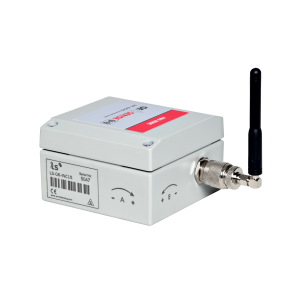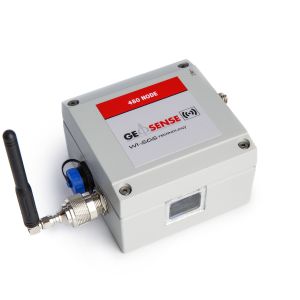Wi-SOS 480

The Wi-SOS 480 (Wireless Sensor Observation System) provides a system to transmit, receive and data log remotely signals from any sensor with a vibrating wire, voltage, 4-20mA, SDI12 or resistance output over long ranges up to 15 km.
Stand-alone Wireless Tilt Meters are also available which can be integrated into the system, together with any type of Node. The user can configure, diagnose, and download from a mobile device using android technology.
The system has passed London Underground requirements for fire safety and electromagnetic compatibility and minimises cable runs for asset monitoring of tunnels and shafts. The system has the LUL product ID number 3576.
The Wi-SOS 480 is a star network consisting of a series of wireless nodes and a gateway. The gateway collects the data from the long-range star network, stores it locally and it is available to view and/or download via GPRS, wired Ethernet or Wi-Fi. No system planning is required and repeaters are not required, saving on installation costs.
What makes Wi-SOS 480 different to other wireless systems is the use of data modulation via the Worldsensing G6 Platform which uses the latest LoRa spread spectrum technology. This technology means long range, low cost, low power consumption and high connectivity.
Software is embedded in the gateway, which allows it to be fully configurable over air or Ethernet and a fast mode allows full diagnostics to ensure correct operation of the system.
The Wi-SOS 480 Web Centre provides a platform to download data and view it on PC, tablet or mobile phone; or the data can be forwarded to any FTP for inputting into most visualisation software.
The Wi-SOS 480 offers a highly flexible and cost-effective solution for projects where a cabled solution is not possible due to physical barriers and/or access restrictions and where near real-time monitoring is required.
Wi-SOS 480 Tilt Meter

The Geosense® Wi-SOS 480 Wireless Tilt Meter is used for long-range, remote readings in geotechnical monitoring applications.
The tilt meter combines a high-precision biaxial MEMS sensor with a radio transmission network to provide accurate measurements with the benefits of long-range wireless communication and extended battery life.
What makes Wi-SOS 480 different to other wireless systems is the use of data modulation via the Worldsensing G6 Platform which uses the latest LoRa spread spectrum technology. This technology means Long Range, Low Cost, Low Power Consumption and High Connectivity.
Each unit is individually calibrated to provide the ultimate in system accuracy and repeatability.
Several hundred Wireless Tilt Meters can be supported by one Gateway in the same network and it can also be used as a stand-alone logger for manual monitoring, capable of storing up to 200,000 readings.
It can easily be configured and connected with a USB cable and an Android device. Connectivity to the Gateway can be checked in the field and its global location displayed via the Wi-SOS WebCentre.
Wi-SOS 480 Laser Distance Meter Node

The laser distance meter node measures the relative distance between pairs of reference points. One of the two points can be a natural surface or target foils while the node can be placed at the other end point.
Measurement of tunnel convergence is one of the most important controls of the NATM (New Austrian Tunneling Method) construction. Portable devices like tape extensometers, levels and temporarily installed total stations allow sporadic measurements. On the other hand, one of the most commonly used methods, the measuring tape, disrupts construction activities due to the use of aerial work platforms.
Laser distance nodes can be easily relocated along the convergence cross sections up to the excavation front or until the measured relative displacements are stabilised when the required frequency of measurements is reduced. They can also be used when permanent monitoring is required.
In a similar way, the laser distance node measures deformations in underground excavations and mining without causing work disruptions and delays.
The laser distance node is capable of measuring the relative distance and transmitting the data via long-range radio to a gateway connected to the Internet. One gateway can support hundreds of nodes in the same network that is also measuring other sensors installed in the monitoring sections (borehole extensometers, pressure cells, load cells, strain gauges etc). It can be easily configured and connected with a USB cable and an Android phone.
Wi-SOS 480 Signal Test Kit

One of the main problems for wireless systems, particularly in dense urban environments, is the reliability of signal strength. The Wi-SOS 480 Test Kit allows the suitability of a wireless sensor network to be checked prior to installation. This minimises the risk of installing a costly wireless system only to find its performance is unreliable and it needs to replaced by conventional cabling.
Instrumentation and Monitoring Contractors are finding it a useful asset in their pre-tender system-design and costings and it has enabled them to put forward wireless system proposals to their clients with confidence.
The Worldsensing G6 platform technology used in the Wi-SOS 480 now makes it possible to carry out a simple signal coverage test in four easy steps:
- Position the Gateway
- Connect Node to Tablet
- Carry out readings around the site area
- View signal strength via Wi-SOS WebCentre
A test takes as little as a couple of hours with minimal expertise and the data is available in real time via the internet.